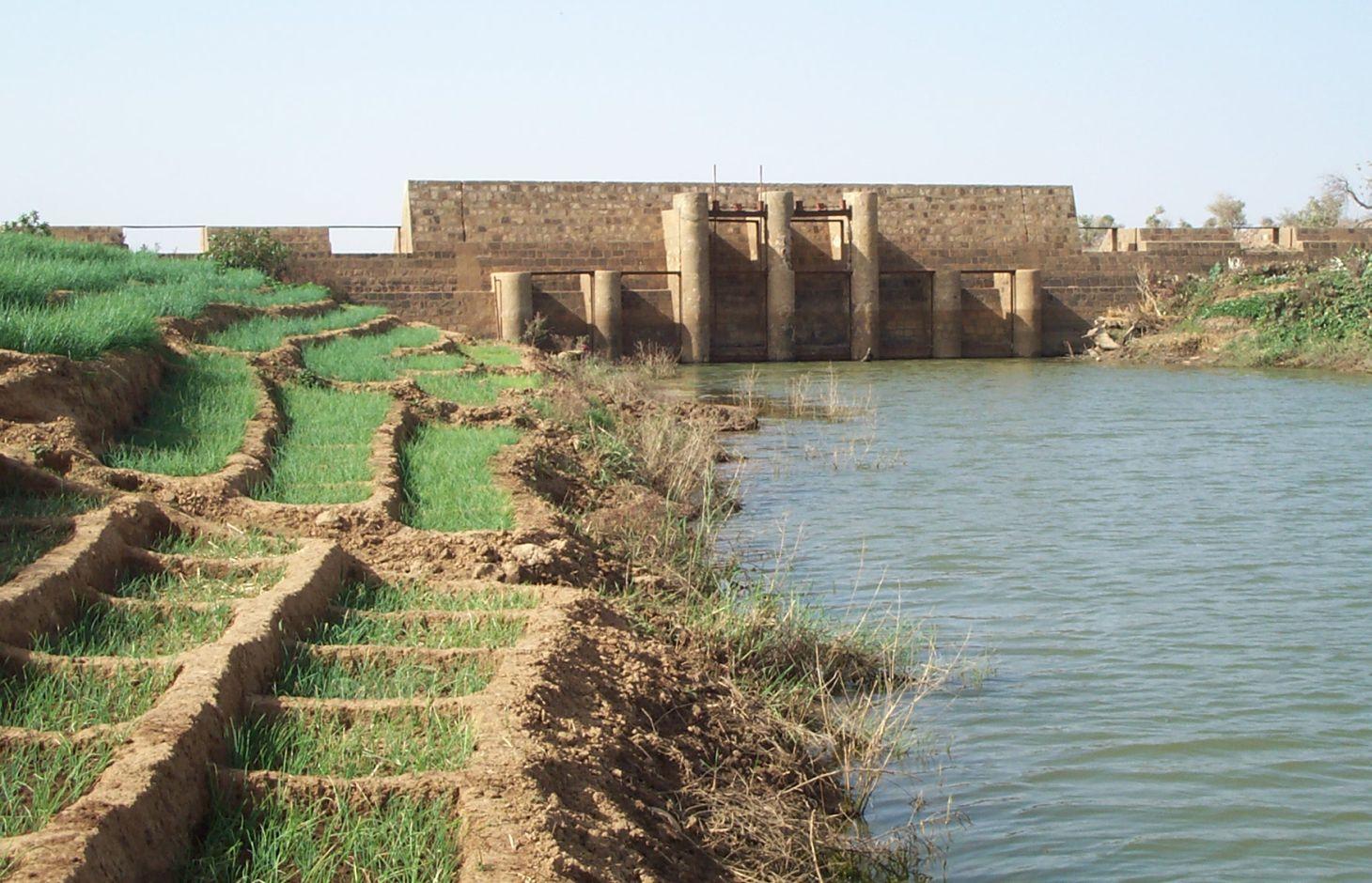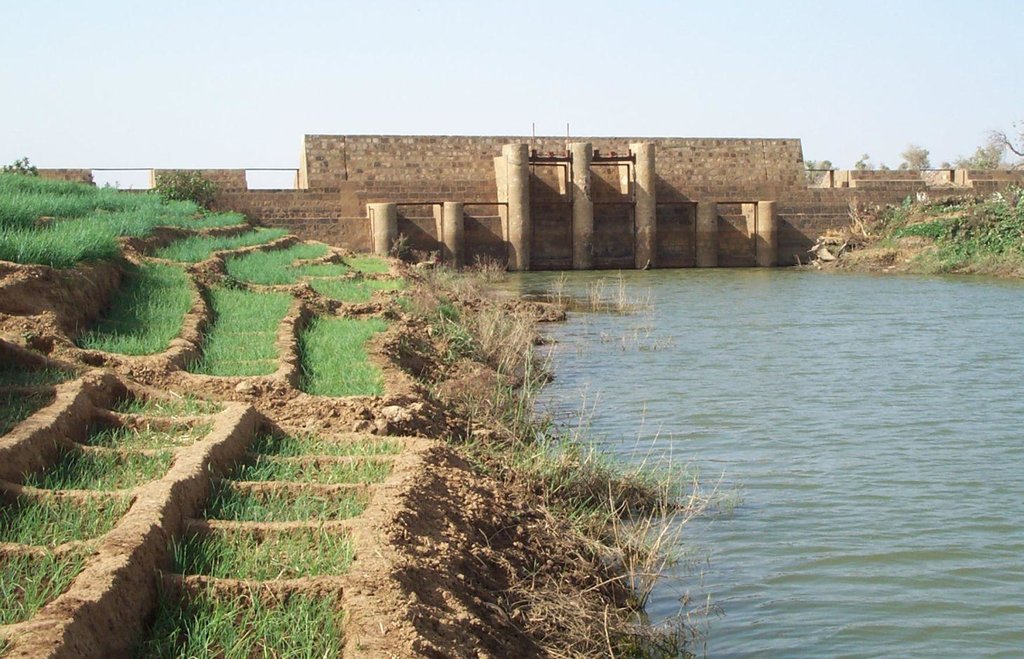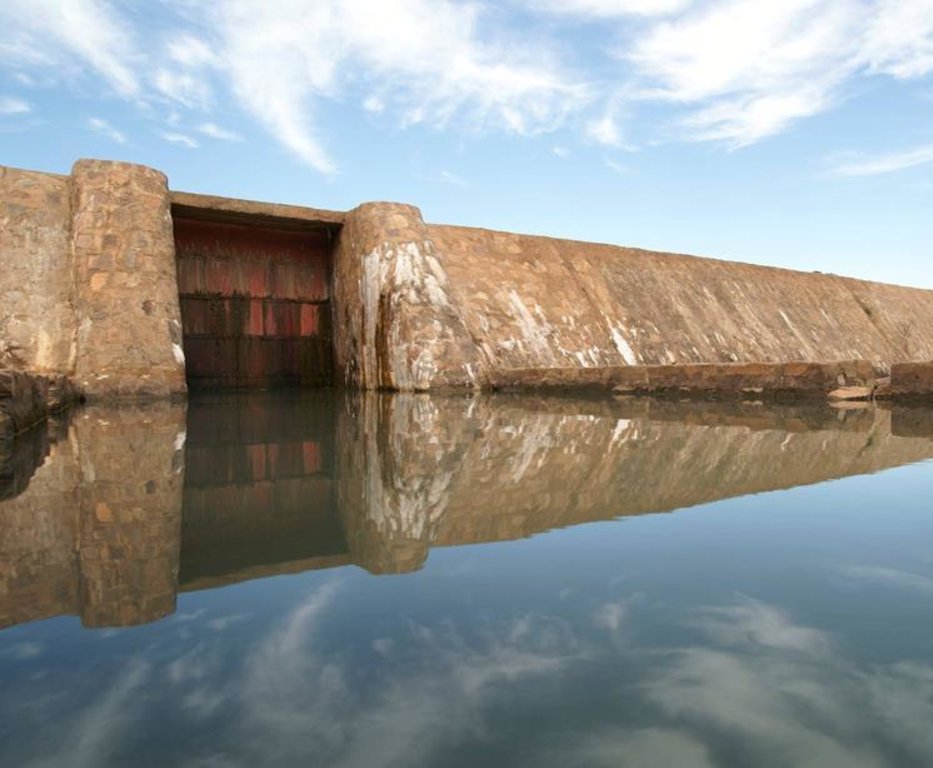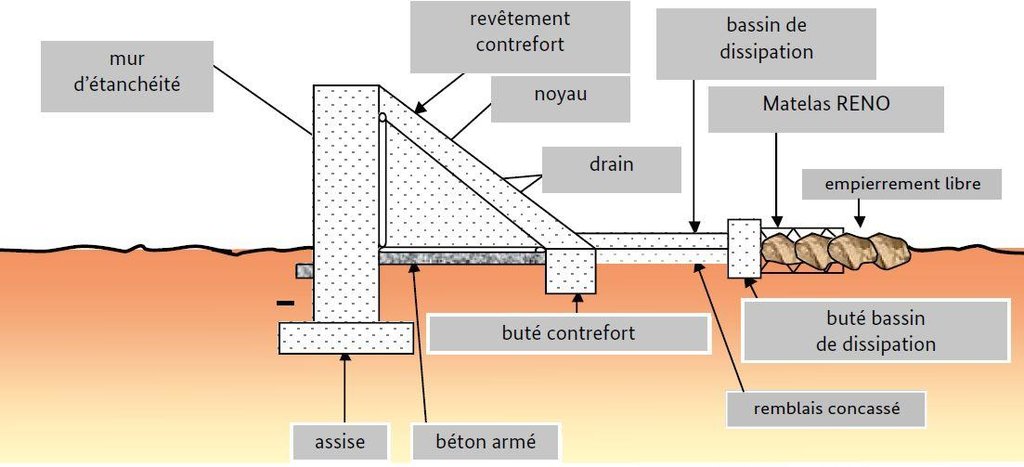Small-scale dams [马里]
- 创建:
- 更新:
- 编制者: Dieter Nill
- 编辑者: –
- 审查者: Deborah Niggli, Alexandra Gavilano
Micro-barrages (French)
technologies_1623 - 马里
查看章节
全部展开 全部收起1. 一般信息
1.2 参与该技术评估和文件编制的资源人员和机构的联系方式
SLM专业人员:
Abdou Sani Mamadou
Programme d’Appui à l’agriculture Productive (PROMAP), Niamey, Niger
尼日尔
有助于对技术进行记录/评估的项目名称(如相关)
Manual of Good Practices in Small Scale Irrigation in the Sahel (GIZ )有助于对技术进行记录/评估的机构名称(如相关)
Deutsche Gesellschaft für Internationale Zusammenarbeit (GIZ) - 德国1.3 关于使用通过WOCAT记录的数据的条件
编制者和关键资源人员接受有关使用通过WOCAT记录数据的条件。:
是
1.4 所述技术的可持续性声明
这里所描述的技术在土地退化方面是否存在问题,导致无法被认为是一种可持续的土地管理技术?:
否
2. SLM技术的说明
2.1 技术简介
技术定义:
Small-scale dams are moderately-sized barriers built across valley bottoms to retain water from permanent watercourses or seasonal flows.
2.2 技术的详细说明
说明:
They can range in length from 100 to 200 m, and the dam wall is usually between 2 and 4 m high. Small-scale dams impound permanent or seasonal water behind them, covering areas from 5 to 15 hectares. They are built with buttresses and a stilling basin. Depending on local conditions, the dam wall can be made of quarry stone joined with mortar or concrete. The dikes are made of earth and can be reinforced with stones. Some such structures are built as bridge dams, providing a means of crossing the valley. The effect on the water table depends on the depth at which the dam is anchored. The deeper the foundation, the more groundwater is retained. Sometimes, they are fitted with geomembranes which extend down deeper to retain more groundwater.
In the rainy season, water gradually accumulates behind the dike, increasing the availability of surface water during the rainy season and groundwater in the dry season. The land is farmed upstream and downstream both in the rainy season and the dry season. During the rainy season, rice is grown, and the areas around the body of water are used for other crops (flood-recession cropping). Dams increase the area of farmable land, yields and production. The water is also used for livestock, for fish farming and sometimes for household needs. The recharged water table feeds market garden wells, enabling farmers to grow vegetables in the dry season and permitting two or three crop harvests a year which increases the availability of food, providing income for farmers and guaranteeing work all year round. This improves the stability of local communities, increases their income and raises their standard of living.
Sustainable operation and management depend directly on the participatory approach. At the planning stage, the condition of the valley upstream and downstream and all user groups must be taken into account. The question of land tenure, in particular, must be settled before construction begins. It must be determined who the owner of the bottomlands is, who will be entitled to use them once the dam has been constructed, what uses will be permitted and under what conditions. The question of project ownership and upkeep must also be clarified. Today, the role of project owner is normally assigned to the commune authorities, although management of the dam is often delegated to a management committee. In order to avoid conflicts, it is essential to take into account all the user groups, livestock keepers in particular. Watering corridors must be established to prevent animals from damaging the crops. In order to maximise the value of the investment, well-organised management committees must be set up to ensure efficient crop production and oversee maintenance work. A management committee controls the opening and closing of the gates. It organises the maintenance of the structure and the implementation of any additional measures necessary to protect the gabion structures and stone bunds. It also collects and manages funds for the maintenance of the dam and organises meetings of farmers. In dry periods, it is important to manage water resources in such a way that downstream areas have enough water. When a series of dams are built on the same watercourse, an inter-dam committee may be required to manage the distribution of water and avoid conflicts between the users of the different dams.
Well-constructed small-scale dams last at least 50 years with a certain amount of upkeep. A high standard of technical planning and construction is required for small-scale dams to avoid subsequent damage. Depending on the natural characteristics of the watershed, small-scale dams may require additional SWC/SPR measures upstream to protect them from siltation.
These small-scale dams are suitable for use in narrower valleys, as a considerable volume of water can be impounded with a relatively short structure. They are not as well suited to wide, gently sloping valleys, as very long dikes are required and this increases the cost.
2.3 技术照片
2.5 已应用该技术的、本评估所涵盖的国家/地区/地点
国家:
马里
区域/州/省:
Mali
具体说明该技术的分布:
- 均匀地分布在一个区域
如果不知道精确的区域,请注明大致覆盖的区域:
- 0.1-1 平方千米
注释:
Small-scale dams impound permanent or seasonal water behind them, covering areas from 5 to 15 hectares
2.6 实施日期
如果不知道确切的年份,请说明大概的日期:
- 10-50年前
2.7 技术介绍
详细说明该技术是如何引入的:
- 通过项目/外部干预
注释(项目类型等):
developed, implemented and disseminated as part of projects and programmes undertaken from the 1980s onwards to combat desertification and improve natural resource management. Implemented by GIZ (German Federal Enterprise for International Cooperation), and the project to rehabilitate dams and tracks (PRBP) and the Mali north programme (PMN)
3. SLM技术的分类
3.1 该技术的主要目的
- 改良生产
3.2 应用该技术的当前土地利用类型

农田
- 一年一作
每年的生长季节数:
- 1
具体说明:
Longest growing period in days: 120, Longest growing period from month to month: August to October

水道、水体、湿地
- 池塘、大坝
注释:
Major land use problems (compiler’s opinion): lack of irrigation water, surface water, soil erosion by water and wind
Constraints of common grazing land
Constraints of forested government-owned land or commons
3.4 供水
该技术所应用土地的供水:
- 混合雨水灌溉
3.5 该技术所属的SLM组
- 灌溉管理(包括供水、排水)
- 引水和排水
- 地表水管理(泉、河、湖、海)
3.6 包含该技术的可持续土地管理措施

结构措施
- S5:大坝、集水斗、水池
3.7 该技术强调的主要土地退化类型

化学性土壤退化
- Cn:肥力下降和有机质含量下降(非侵蚀所致)

生物性退化
- Bc:植被覆盖的减少

水质恶化
- Ha:干旱化
- Hg:地下水/含水层水位的变化
注释:
Main causes of degradation: crop management (annual, perennial, tree/shrub), floods, droughts, population pressure, land tenure
3.8 防止、减少或恢复土地退化
具体数量名该技术与土地退化有关的目标:
- 防止土地退化
- 修复/恢复严重退化的土地
4. 技术规范、实施活动、投入和成本
4.1 该技术的技术图纸
技术规范(与技术图纸相关):
They can range in length from 100 to 200 m, and the dam wall is usually between 2 and 4 m high.
Technical knowledge required for field staff / advisors: high
Technical knowledge required for land users: low
Main technical functions: control of dispersed runoff: retain / trap, control of concentrated runoff: retain / trap, increase of infiltration, increase / maintain water stored in soil, increase of groundwater level / recharge of groundwater, water harvesting / increase water supply
Secondary technical functions: increase in organic matter, increase in nutrient availability (supply, recycling,…), sediment retention / trapping, sediment harvesting, increase of biomass (quantity), promotion of vegetation species and varieties (quality, eg palatable fodder)
Dam/ pan/ pond
Depth of ditches/pits/dams (m): 2-4
Length of ditches/pits/dams (m): 100-200
作者:
PIPRO-DB
4.3 技术建立活动
| 活动 | 时间(季度) | |
|---|---|---|
| 1. | At the planning stage, the condition of the valley upstream and downstream and all user groups must be taken into account. The question of land tenure must be settled before construction begins. The question of project ownership and upkeep must also be clarified. | |
| 2. | In order to avoid conflicts, it is essential to take into account all the user groups, livestock keepers in particular | |
| 3. | Construction of dam | |
| 4. | Watering corridors must be established to prevent animals from damaging the crops | |
| 5. | well-organised management committees must be set up to ensure efficient crop production and oversee maintenance work |
4.5 维护/经常性活动
| 活动 | 时间/频率 | |
|---|---|---|
| 1. | A management committee controls the opening and closing of the gates. It organises the maintenance of the structure and the implementation of any additional measures necessary to protect the gabion structures and stone bunds. It also collects and manages funds for the maintenance of the dam and organises meetings of farmers | |
| 2. | Depending on the natural characteristics of the watershed, small-scale dams may require additional SWC/SPR measures upstream to protect them from siltation. |
4.7 影响成本的最重要因素
描述影响成本的最决定性因素:
The cost of small-scale dams varies greatly depending on the physical characteristics of the site, the size of the structure and the local availability of materials. In Dogon country, in Mali, the PDRT project constructed dams with cyclopean concrete costing an average of around 20 million CFA francs and between 3 and 5 million CFA francs per hectare. The internal rate of return of the dams built averaged 17% (Nill & Kobilke, 2002). Larger dams built in the Beledougou area cost 100-140 million CFA francs. Helvetas Swiss Intercooperation reports costs of around 20 million CFA francs for areas of 10-80 hectares (PASSIP, 2012).
5. 自然和人文环境
5.1 气候
年降雨量
- < 250毫米
- 251-500毫米
- 501-750毫米
- 751-1,000毫米
- 1,001-1,500毫米
- 1,501-2,000毫米
- 2,001-3,000毫米
- 3,001-4,000毫米
- > 4,000毫米
农业气候带
- 半干旱
Thermal climate class: subtropics
5.2 地形
平均坡度:
- 水平(0-2%)
- 缓降(3-5%)
- 平缓(6-10%)
- 滚坡(11-15%)
- 崎岖(16-30%)
- 陡峭(31-60%)
- 非常陡峭(>60%)
地形:
- 高原/平原
- 山脊
- 山坡
- 山地斜坡
- 麓坡
- 谷底
垂直分布带:
- 0-100 m a.s.l.
- 101-500 m a.s.l.
- 501-1,000 m a.s.l.
- 1,001-1,500 m a.s.l.
- 1,501-2,000 m a.s.l.
- 2,001-2,500 m a.s.l.
- 2,501-3,000 m a.s.l.
- 3,001-4,000 m a.s.l.
- > 4,000 m a.s.l.
5.3 土壤
平均土层深度:
- 非常浅(0-20厘米)
- 浅(21-50厘米)
- 中等深度(51-80厘米)
- 深(81-120厘米)
- 非常深(> 120厘米)
土壤质地(表土):
- 中粒(壤土、粉土)
- 细粒/重质(粘土)
5.4 水资源可用性和质量
地下水位表:
5-50米
地表水的可用性:
中等
5.5 生物多样性
物种多样性:
- 低
5.6 应用该技术的土地使用者的特征
相对财富水平:
- 非常贫瘠
- 贫瘠
机械化水平:
- 手工作业
- 畜力牵引
性别:
- 男人
说明土地使用者的其他有关特征:
Population density: 10-50 persons/km2
Annual population growth: 3% - 4% (mostly poor households below poverty line).
Off-farm income specification: men migrate temporarily or permanently to cities for off-farm income
5.7 应用该技术的土地使用者使用的平均土地面积
- < 0.5 公顷
- 0.5-1 公顷
- 1-2 公顷
- 2-5公顷
- 5-15公顷
- 15-50公顷
- 50-100公顷
- 100-500公顷
- 500-1,000公顷
- 1,000-10,000公顷
- > 10,000公顷
这被认为是小规模、中规模还是大规模的(参照当地实际情况)?:
- 小规模的
5.8 土地所有权、土地使用权和水使用权
土地所有权:
- 州
土地使用权:
- 社区(有组织)
用水权:
- 社区(有组织)
注释:
traditional land use rights on fields, communal land on pasture and forest land
5.9 进入服务和基础设施的通道
健康:
- 贫瘠
- 适度的
- 好
教育:
- 贫瘠
- 适度的
- 好
技术援助:
- 贫瘠
- 适度的
- 好
就业(例如非农):
- 贫瘠
- 适度的
- 好
市场:
- 贫瘠
- 适度的
- 好
能源:
- 贫瘠
- 适度的
- 好
道路和交通:
- 贫瘠
- 适度的
- 好
饮用水和卫生设施:
- 贫瘠
- 适度的
- 好
金融服务:
- 贫瘠
- 适度的
- 好
6. 影响和结论性说明
6.1 该技术的现场影响
社会经济效应
生产
作物生产
饲料生产
生产故障风险
生产区域
水资源可用性和质量
灌溉用水需求
社会文化影响
食品安全/自给自足
contribution to human well-being
注释/具体说明:
The water impounded by small-scale dams makes it possible to farm a much larger area in the valley bottoms and ensures better yields in the rainy season and also in the off-season. The production of food staples and market garden output increases significantly. More intense production ensures employment all year round, which improves the stability of local communities, increases their income and raises their standard of living.
生态影响
水循环/径流
水量
水的回收/收集
地下水位/含水层
土壤
土壤水分
土壤覆盖层
土壤流失
养分循环/补给
生物多样性:植被、动物
有益物种
6.2 该技术的场外影响已经显现
旱季稳定可靠的水流
下游洪水
下游淤积
6.3 技术对渐变气候以及与气候相关的极端情况/灾害的暴露和敏感性(土地使用者认为的极端情况/灾害)
渐变气候
渐变气候
| 季节 | 增加或减少 | 该技术是如何应对的? | |
|---|---|---|---|
| 年温度 | 增加 | 好 |
气候有关的极端情况(灾害)
气象灾害
| 该技术是如何应对的? | |
|---|---|
| 局地暴雨 | 好 |
| 局地风暴 | 好 |
气候灾害
| 该技术是如何应对的? | |
|---|---|
| 干旱 | 好 |
水文灾害
| 该技术是如何应对的? | |
|---|---|
| 比较和缓的(河道)洪水 | 好 |
其他气候相关的后果
其他气候相关的后果
| 该技术是如何应对的? | |
|---|---|
| 缩短生长期 | 好 |
6.4 成本效益分析
技术收益与技术建立成本相比如何(从土地使用者的角度看)?
短期回报:
积极
长期回报:
非常积极
技术收益与技术维护成本/经常性成本相比如何(从土地使用者的角度看)?
短期回报:
非常积极
长期回报:
非常积极
6.7 该技术的优点/长处/机会
| 编制者或其他关键资源人员认为的长处/优势/机会 |
|---|
| The small-scale dams create water reserves. When there is not enough rain or during dry spells in the rainy season, the dams retain enough water for crops throughout their growth cycle. If rain-fed crops fail, production in the valley bottoms can mitigate these losses. In wet years, the dams regulate the flow of water, preventing heavy floodwaters from causing damage to land downstream. |
| The water impounded by small-scale dams makes it possible to farm a much larger area in the valley bottoms and ensures better yields in the rainy season and also in the off-season. The production of food staples and market garden output increases significantly. More intense production ensures employment all year round, which improves the stability of local communities, increases their income and raises their standard of living. |
| In the dry season, the recharged water table makes a second and even third crop harvest possible, increasing the availability of food, providing income for farmers and guaranteeing work all year round. |
| Replenished water tables not only improve crop output, they also reduce the time and effort that women devote to fetching water and make it easier to water livestock. |
6.8 技术的弱点/缺点/风险及其克服方法
| 编制者或其他关键资源人员认为的弱点/缺点/风险 | 如何克服它们? |
|---|---|
| A high standard of technical planning and construction is required for small-scale dams to avoid subsequent damage. | In order to maximise the value of the investment, well-organised management committees must be set up to ensure efficient crop production and oversee maintenance work. |
7. 参考和链接
7.1 信息的方法/来源
- 实地考察、实地调查
- 与土地使用者的访谈
(现场)数据是什么时候汇编的?:
01/07/2012
7.2 参考可用出版物
标题、作者、年份、ISBN:
Good Practices in Soil and Water Conservation. A contribution to adaptation and farmers´ resilience towards climate change in the Sahel. Published by GIZ in 2012.
可以从哪里获得?成本如何?
http://agriwaterpedia.info/wiki/Main_Page
链接和模块
全部展开 全部收起链接
无链接
模块
无模块





